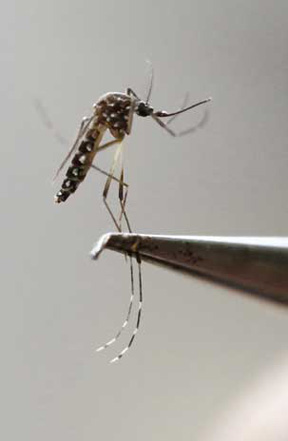 RIO DE JANEIRO: Research by scientists in Brazil indicates that a mosquito more common than the one primarily known to transmit Zika infections may possibly be able to carry the virus, a development that could further complicate efforts to limit its spread.
RIO DE JANEIRO: Research by scientists in Brazil indicates that a mosquito more common than the one primarily known to transmit Zika infections may possibly be able to carry the virus, a development that could further complicate efforts to limit its spread.
The mosquito species Aedes aegypti has been identified as the primary transmitter of Zika infections, which have been linked to thousands of birth defects as the virus spreads rapidly in Brazil and other countries in Latin America and the Caribbean.
But the scientists in Brazil announced that they were able to infect another species, Culex quinquefasciatus, with the virus in a laboratory, raising concerns that Zika could be carried by a species more prevalent than Aedes aegypti. They said much more research is needed to learn whether the Culex mosquitoes can transmit Zika infections.
In Brazil, Culex quinquefasciatus is 20 times more common than Aedes aegypti, the researchers said.
The research, conducted by scientists at the government-funded Oswaldo Cruz Foundation in the northeastern city of Recife, is part of an ongoing trial in which researchers injected 200 of the Culex quinquefasciatus mosquitoes with rabbit blood infected by Zika.
The virus, they said, circulated through the mosquitoes’ bodies and into their salivary glands, meaning they might be able to transmit a Zika infection by biting a person.
“We saw an ease of infection and an ease of dissemination of the virus to the salivary glands,” Constancia Ayres, the lead scientist in the study, told Globo, Brazil’s leading television network.
The research has yet to be published in a scientific journal or reviewed by scientific peers elsewhere.
The foundation said more work was needed to determine whether Culex mosquitoes in the wild already are carrying the virus as well as whether they can transmit Zika infections.
Foundation spokeswoman Fabiola Tavares said the researchers, who will begin capturing Culex mosquitoes in areas near Recife where the virus is known to be circulating, will now proceed toward answering those questions. The additional research could take up to eight months, Tavares added.
If a mosquito besides Aedes aegypti were found to transmit Zika infections, it could make it more difficult to contain the current Zika outbreak that the World Health Organization last month declared a global public health emergency.
Much remains unknown about Zika, including whether the virus actually causes microcephaly in babies, a condition defined by unusually small heads that can result in developmental problems.
Brazil said it has confirmed more than 640 cases of microcephaly, and considers most of them to be related to Zika infections in the mothers. Brazil is investigating more than 4,200 additional suspected cases of microcephaly.
Traces of Zika virus have been found in the bodily fluids and tissue of mothers and babies affected by microcephaly.
Culex quinquefasciatus also exists in more temperate climes, such as the southern United States, where it is known to carry the West Nile virus, and can survive winters. Unlike Aedes aegypti, Culex quinquefasciatus could keep a virus in circulation during cold months.
Though the Culex mosquitoes prefer to feed on the blood of birds, they also commonly bite humans, especially in rural areas. That means that targeted pesticide use and other mosquito control efforts for that species, which rests in trees and other high areas, would need to be different from those for Aedes aegypti, which rests in low spots, often indoors.
“You can’t spray up high the way you can around buildings,” said Grayson Brown, director of the University of Kentucky’s public health entomology laboratory who was not involved in the Oswaldo Cruz Foundation research.
If Culex mosquitoes were indeed proven to transmit Zika, Brown said, “it would really complicate the public health issue.” -AP






